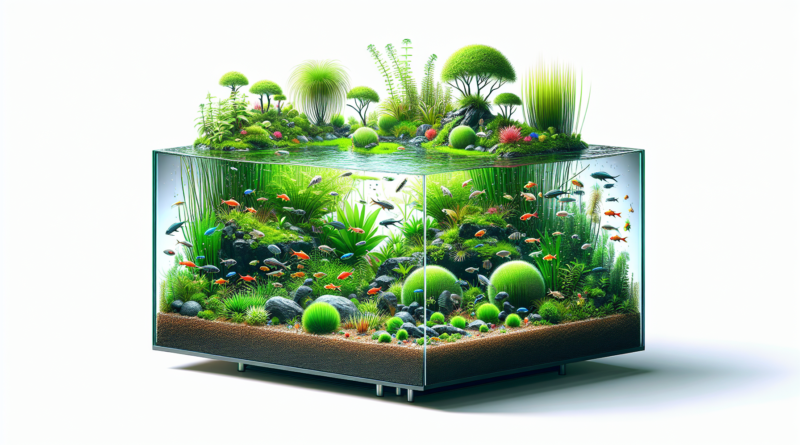Nano-Aquarium Ecosystem Design
Imagine creating a tiny world within the confines of a glass container, where plants thrive, animals flourish, and an entire ecosystem comes to life. This is the enchanting concept behind nano-aquarium ecosystem design. Just like a regular aquarium, but on a smaller scale, these miniature underwater environments offer a fascinating glimpse into the intricacies of nature. From carefully selecting the right plant and animal species to maintaining the delicate balance of nutrients and oxygen, the design and care of nano-aquarium ecosystems is an art form that combines creativity, science, and a passion for the natural world. Get ready to embark on a journey into a captivating microcosm, where the wonders of aquatic life unfold before your eyes.
Nano-Aquarium Ecosystem Design
Introduction
What is a nano-aquarium ecosystem?
A nano-aquarium ecosystem is a miniature aquatic environment that replicates the natural balance and beauty of larger aquariums on a smaller scale. It typically consists of a small tank or container that houses a variety of aquatic plants, fish, and invertebrates. These self-contained ecosystems require careful design and maintenance to thrive.
Benefits of nano-aquarium ecosystems
Nano-aquarium ecosystems offer several benefits to aquarium enthusiasts. Firstly, their compact size makes them ideal for people with limited space, such as those living in apartments or dorm rooms. Additionally, these ecosystems can be visually stunning, with vibrant plant life and colorful fish creating a captivating display. Nano-aquariums also provide a sense of natural tranquility and serve as a reminder of the beauty and fragility of the natural world. Finally, these ecosystems can be a learning opportunity for both children and adults, as they offer a hands-on experience in understanding aquatic ecosystems and their inhabitants.
Setting up a Nano-Aquarium Ecosystem
Choosing the right tank size
When selecting a tank for your nano-aquarium ecosystem, consider the space you have available and the species you intend to keep. Smaller tanks, such as those with a capacity of 5 to 10 gallons, are popular choices for nano-aquariums due to their compact size. However, keep in mind that smaller tanks may require more frequent maintenance and can limit the variety of species you can house.
Selecting the appropriate substrate
The substrate is the material placed at the bottom of the tank and serves as a base for plants and provides a habitat for beneficial bacteria. Choose a substrate that is suitable for the types of plants you wish to include in your ecosystem. Options range from gravel and sand to specialized substrates designed for planted tanks. Ensure that the substrate is thoroughly rinsed before adding it to the tank to remove any dust or debris.
Selecting the right water filtration system
Proper water filtration is crucial for maintaining a healthy nano-aquarium ecosystem. Choose a filtration system that is recommended for the size of your tank and the needs of your chosen species. Consider a combination of mechanical, biological, and chemical filtration to effectively remove debris, control ammonia, and maintain water clarity.
Choosing the right lighting
Lighting is essential for the growth of aquatic plants in a nano-aquarium ecosystem. Select a lighting system that provides the appropriate intensity and spectrum of light for your plants’ needs. LED lights are commonly used in nano-aquariums due to their energy efficiency, adjustable intensity, and ability to mimic natural sunlight.
Selecting suitable aquatic plants
Aquatic plants are key components of nano-aquarium ecosystems as they provide oxygen, remove toxins, and create a natural habitat for fish and invertebrates. Choose plants that are suitable for the size and lighting conditions of your tank. Popular choices include java fern, anubias, and dwarf hairgrass. Research the specific care requirements of each plant to ensure their success in your ecosystem.
Selecting the appropriate fish and invertebrates
When selecting fish and invertebrates for your nano-aquarium ecosystem, consider their compatibility with each other and the size of your tank. Opt for small, peaceful species that can thrive in a smaller environment. Some popular choices for nano-aquariums include betta fish, guppies, shrimp, and snails. Avoid overcrowding the tank and research the specific needs and behaviors of each species before adding them to your ecosystem.
Maintaining a Nano-Aquarium Ecosystem
Monitoring water parameters
Regular monitoring of water parameters is essential for maintaining a healthy nano-aquarium ecosystem. Test the water for parameters such as temperature, pH, ammonia, nitrite, and nitrate levels. Keep a log of the results to track any changes over time and address any issues promptly.
Cleaning and water changes
Regular cleaning and water changes are necessary for maintaining water quality in a nano-aquarium ecosystem. Remove any debris, uneaten food, and dead plant matter from the tank. Perform partial water changes on a regular basis to remove accumulated toxins and ensure optimal water quality.
Feeding and nutrition
Provide appropriate nutrition for the inhabitants of your nano-aquarium ecosystem. Feed your fish and invertebrates a varied diet that includes high-quality commercial foods and occasional treats such as frozen or live foods. Avoid overfeeding, as excess food can lead to water quality issues.
Pruning and trimming plants
Aquatic plants in a nano-aquarium ecosystem may require periodic pruning and trimming to maintain their shape and prevent overgrowth. Use clean, sharp scissors or pruning tools to carefully remove any dead or damaged leaves and trim excessive growth. This will help promote balanced plant growth and prevent overcrowding.
Controlling algae growth
Algae is a common issue in aquariums, including nano-aquarium ecosystems. To control algae growth, maintain proper lighting levels, limit nutrient levels through regular water changes, and consider adding algae-eating species such as nerite snails or Siamese algae eaters. Avoid overfeeding, as excess nutrients can contribute to algae growth.
Managing the fish and invertebrate population
Keep a close eye on the population of fish and invertebrates in your nano-aquarium ecosystem. Ensure that the tank is not overstocked and that the species coexist peacefully. If necessary, consider rehoming or separating aggressive or incompatible individuals to maintain a harmonious ecosystem.
Enhancing the Nano-Aquarium Ecosystem
Adding live rock and other natural decorations
To enhance the visual appeal and provide additional shelter for fish and invertebrates, consider adding live rock or other natural decorations to your nano-aquarium ecosystem. Live rock can provide a natural habitat for beneficial bacteria and may also introduce interesting microfauna to the ecosystem.
Introducing live corals and other invertebrates
For those interested in creating a reef-like nano-aquarium ecosystem, live corals and other invertebrates can be added. However, keep in mind that these organisms have specific care requirements and may require more advanced equipment and maintenance.
Creating a balanced food chain
To promote a balanced and self-sustaining ecosystem, consider establishing a food chain within your nano-aquarium. This can involve adding small fish or invertebrates as prey for larger species or introducing detritivores to consume organic waste.
Boosting biodiversity
Increase biodiversity in your nano-aquarium ecosystem by adding a variety of species that interact and contribute to the overall ecosystem health. Choose species that fill different ecological niches and have different feeding behaviors.
Creating microhabitats
Provide a variety of microhabitats within your nano-aquarium ecosystem to cater to the diverse needs of your inhabitants. This can include areas with dense vegetation for hiding, open swimming spaces for active fish, and caves or crevices for shelter.
Common Challenges and Troubleshooting
Dealing with water quality issues
Water quality issues can arise in any aquarium, including nano-aquarium ecosystems. If you notice elevated ammonia, nitrite, or nitrate levels, perform water changes and adjust your filtration system accordingly. Regular monitoring and maintenance can prevent and address water quality issues.
Addressing algae outbreaks
Algae outbreaks are common in aquariums and can be managed through proper maintenance practices. Increase water changes, adjust lighting levels, and consider adding algae-eating organisms to help control excessive algae growth. Avoid using chemical treatments unless absolutely necessary.
Managing fish aggression or compatibility issues
Fish aggression or compatibility issues may occur in a nano-aquarium ecosystem if incompatible species are housed together or if the tank is overcrowded. Observe the behavior of your fish closely and be prepared to separate or rehome aggressive or incompatible individuals to maintain a peaceful environment.
Dealing with disease and parasites
Disease and parasites can affect the health of fish and invertebrates in a nano-aquarium ecosystem. Maintain good water quality, quarantine new additions, and be vigilant for any signs of illness or abnormal behavior. If necessary, consult a veterinarian or aquatic specialist for proper diagnosis and treatment.
Solving equipment malfunctions
Equipment malfunctions can occur unexpectedly and disrupt the balance of a nano-aquarium ecosystem. Regularly inspect and maintain your equipment to prevent malfunctions. Have spare parts on hand and familiarize yourself with troubleshooting techniques to address any issues promptly.
Nano-Aquarium Ecosystem Inspiration
Exploring different design themes and styles
Nano-aquarium ecosystems offer creative possibilities for design and decor. Explore different design themes and styles to create a unique and visually appealing tank. Whether you prefer a lush tropical paradise or a minimalist zen garden, there are endless options to suit your personal taste.
Creating a themed nano-aquarium
Take inspiration from your hobbies, interests, or favorite natural settings to create a themed nano-aquarium. Whether it’s a replica of a coral reef, a serene forest stream, or a tropical rainforest, a themed tank can provide a truly immersive and captivating experience.
Inspiring nano-aquarium designs from around the world
The world of nano-aquarium ecosystems is filled with inspiring designs from passionate hobbyists and professional aquarists. Explore online communities, forums, and websites dedicated to nano-aquariums to discover impressive designs and gain inspiration for your own unique setup.
Tips and Tricks for Success
Understanding the nitrogen cycle
The nitrogen cycle is a vital process in maintaining a healthy nano-aquarium ecosystem. Familiarize yourself with the cycle to understand how beneficial bacteria convert harmful ammonia into less toxic compounds. Properly cycling your tank before adding any inhabitants is crucial.
Maintaining temperature and pH stability
Maintaining stable and appropriate temperature and pH levels is essential for the health and wellbeing of the organisms in your nano-aquarium ecosystem. Use a reliable heater and thermometer to regulate temperature, and regularly test and adjust pH levels as needed.
Choosing the right equipment
Investing in quality equipment is important for the long-term success of your nano-aquarium ecosystem. Choose reliable and efficient equipment, such as heaters, filters, and lighting systems, to ensure optimal conditions for your plants and animals.
Starting slow and gradually adding inhabitants
To establish a stable ecosystem, start with a few hardy species and gradually introduce more inhabitants over time. This allows the tank to adjust and prevents sudden imbalances in water chemistry. Remember to research the specific needs and compatibility of each species before adding them to your tank.
Researching and understanding the needs of the chosen species
Thoroughly research the needs and requirements of the species you plan to include in your nano-aquarium ecosystem. Consider factors such as water parameters, temperature ranges, compatibility, and feeding habits to ensure the best possible care for your organisms.
Conclusion
The beauty and benefits of nano-aquarium ecosystems
Nano-aquarium ecosystems offer a captivating and rewarding experience for aquarium enthusiasts of all levels. The miniature size allows for creativity and innovation in design, while the self-contained nature of these ecosystems provides a sense of calm and tranquility. The visual beauty and the opportunity to observe and care for a thriving mini-ecosystem make nano-aquariums a delightful addition to any space.
The joy of maintaining a thriving mini-ecosystem
Maintaining a nano-aquarium ecosystem brings joy and a sense of fulfillment as you witness the growth and wellbeing of your aquatic plants and inhabitants. The opportunity to learn about and care for an entire ecosystem within the confines of your home is a truly rewarding experience. With proper planning, care, and attention, your nano-aquarium ecosystem can become a captivating and thriving display of nature’s wonders.


